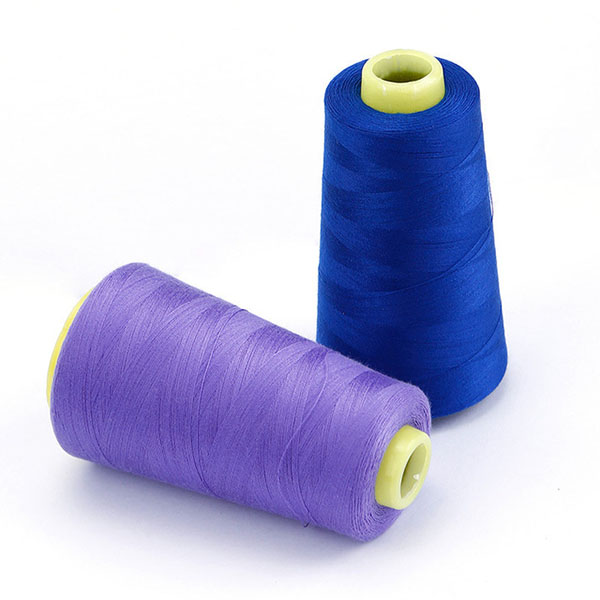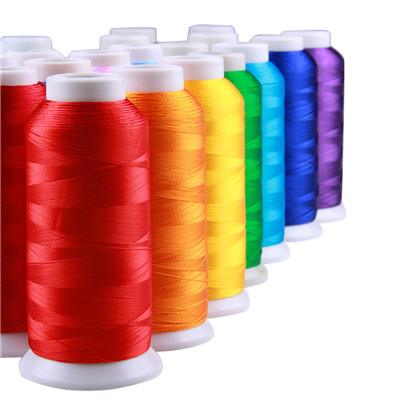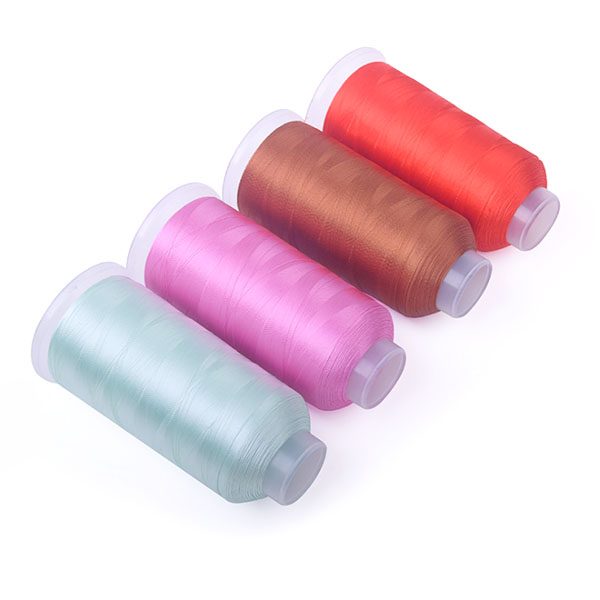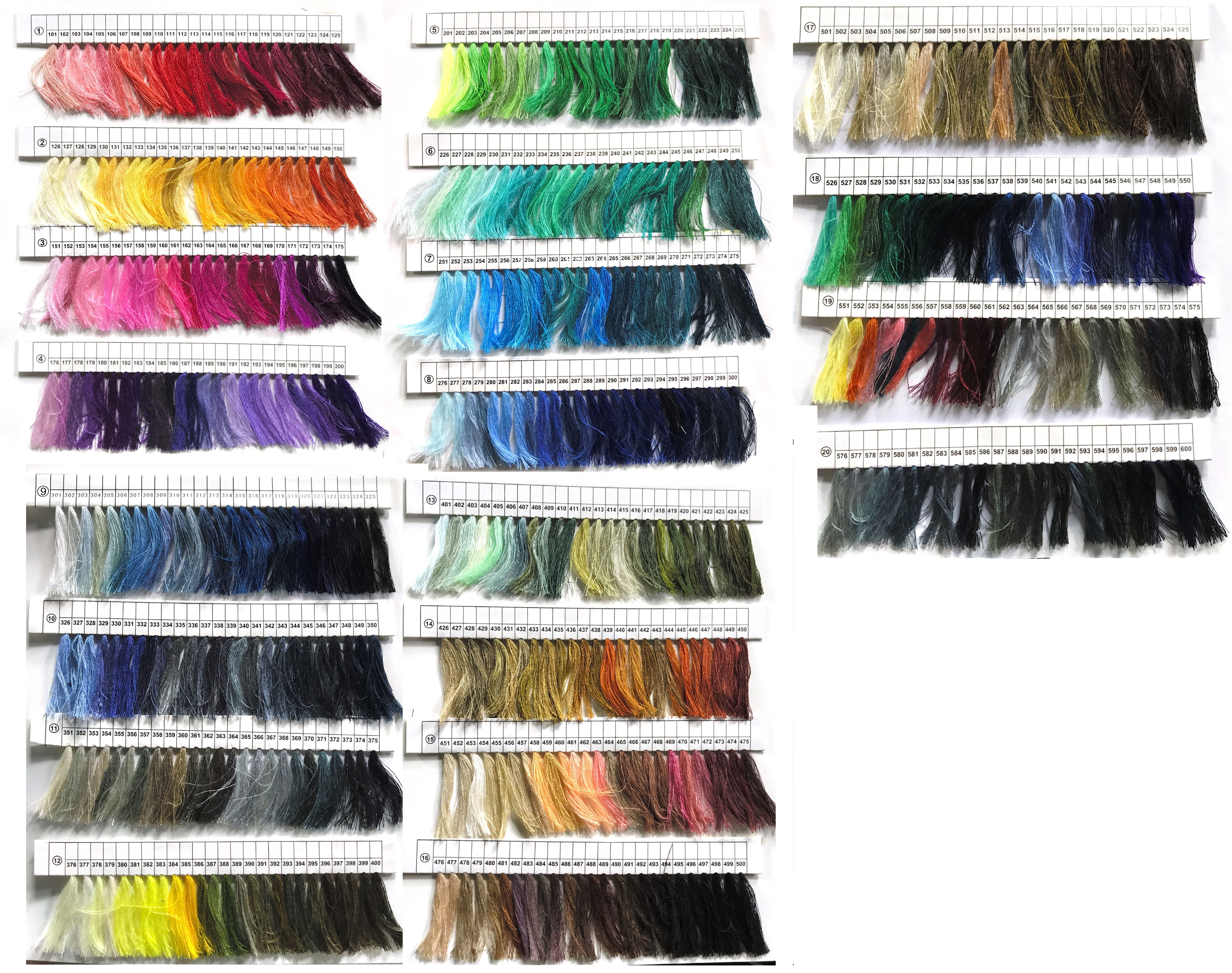40/2 polyester sewing thread is the main thread material, used to sew all kinds of clothing materials, and has dual functions of practicality and decoration. The quality of sewing thread not only affects sewing efficiency and processing cost, but also affects the appearance quality of finished garments.
Classification and characteristics of sewing thread
best sewing thread for clothing are usually divided into three categories according to raw materials: natural fiber sewing thread, synthetic fiber sewing thread and mixed sewing thread.
1. Natural fiber sewing thread
a. Cotton sewing thread: Sewing thread made from cotton fiber through refining, sizing, waxing and other processes. Cotton sewing thread can be divided into no light (or soft line), silk light and wax light.
Cotton sewing thread has high strength and good heat resistance, suitable for high-speed sewing and durable pressing. It is mainly used for sewing cotton fabrics, leather and high-temperature ironing clothes. The disadvantage is poor elasticity and wear resistance.
b. Silk thread: filament thread or silk thread made of natural silk, with excellent luster, its strength, elasticity and wear resistance are better than cotton thread, suitable for sewing all kinds of silk clothing, high-grade woolen clothing, fur and leather clothing, etc.
2. Synthetic fiber sewing thread
a. Polyester sewing thread: This is the most used and popular sewing thread at present. It is made of polyester filament or staple fiber. Polyester sewing thread has the characteristics of high strength, good elasticity, wear resistance, low shrinkage and good chemical stability. It is mainly used for the sewing of denim, sportswear, leather products, wool and military uniforms. It should be noted here that polyester suture has a low melting point and is easy to melt during high-speed sewing, blocking the needle eye and causing the suture to break, so it is necessary to choose a suitable needle.
b. Nylon sewing thread: Nylon sewing thread is made of pure nylon multifilament, which is divided into three types: filament thread, short fiber thread and elastic deformation thread. At present, the main variety is nylon filament thread. It has the advantages of large elongation and good elasticity, and its tensile length at the moment of breaking is three times higher than that of cotton threads of the same specification, so it is suitable for sewing chemical fiber, woolen, leather and elastic clothing. The biggest advantage of nylon sewing thread is its transparency. Because this polyester filament sewing thread is transparent and has good color properties, it reduces the difficulty of sewing and wiring and has a broad development prospect. However, it is limited to the fact that the rigidity of the transparent thread currently on the market is too high, the strength is too low, the stitches are easy to float on the surface of the fabric, and it is not resistant to high temperature, so the sewing speed cannot be too high. At present, this type of thread is mainly used for decals, cutting edges and other parts that are not easily stressed.
c. Vinylon sewing thread: It is made of vinylon fiber, which has high strength and stable stitches. It is mainly used for sewing thick canvas, furniture cloth, labor insurance products, etc.
d. Acrylic sewing thread: made of acrylic fiber, mainly used as decorative thread and Embroidery Machine Thread, the yarn twist is low and the dyeing is bright.

3. Mixed sewing thread
a. Polyester/cotton sewing thread: It is blended with 65% polyester and 35% cotton, which has the advantages of both polyester and cotton. Polyester/cotton sewing thread can not only meet the requirements of strength, wear resistance and shrinkage rate, but also overcome the defect of polyester not being heat resistant.
b. Core-spun sewing thread: Sewing thread made of filament as the core and covered with natural fibers. The strength of the core-spun sewing thread depends on the core thread, and the wear resistance and heat resistance depend on the outer yarn. Therefore, core-spun sewing thread is suitable for high-speed sewing and garments that require high sewing firmness.
The principles that should be followed when using Cotton Wrapped Polyester Thread well
The comprehensive index for evaluating the quality of sewing thread is sewability.

Sewingability refers to the ability of a Polyester Sewing Thread to smoothly form a good stitch under specified conditions and maintain certain mechanical properties in the stitch. While ensuring sewability, the sewing thread also needs to be applied correctly. To do this, the following principles should be followed:
(1) Compatibility with fabric characteristics
The raw materials of sewing thread and fabric are the same or similar to ensure the uniformity of shrinkage rate, heat resistance, abrasion resistance, durability, etc., and avoid the appearance shrinkage caused by the difference between the thread and the fabric.
(2) Consistent with the type of clothing
For special-purpose clothing, special-purpose sewing thread should be considered, such as Polyester Weaving Thread for elastic clothing and heat-resistant, flame-retardant and waterproof sewing thread for fire-fighting clothing.
(3) Coordinate with stitch shape
The stitches used in different parts of the garment are different, and the sewing thread should also be changed accordingly. For example, bulky thread or deformed thread should be used for overlock seam. The double stitch should choose a thread with large extensibility, and the crotch seam and shoulder seam should be firm. , while the button eyeliner needs to be wear-resistant.
How to choose sewing thread
Polyester Sewing Thread is widely used in cotton, chemical fiber and blended fabrics due to its advantages of high strength, good wear resistance, low shrinkage, good moisture absorption and heat resistance, corrosion resistance, not easy to mildew, and no moth-eaten. Sewing. Due to the abundant raw material, relatively low price and good sewability of polyester, polyester sewing thread has dominated the sewing thread. Polyester sewing threads, which are in great demand, can be found in various production suppliers in the market, with different prices and quality. So, how to choose high-quality sewing threads?
SWELL Textile specializes in the production of sewing threads for decades, and teaches you how to choose sewing threads. We should pay attention to the following points when purchasing sewing threads:

First: the material of the thread, the polyester sewing thread produced by SWELL Textile is all made of high-quality raw materials, guaranteed to be 100% polyester.
Second: how many joints are produced during polyester sewing thread wholesale making, what is the twist, the thickness of the sewing thread, and the amount of hairiness. The sewing thread produced by SWELL Textile has uniform thickness, no jamming, continuous threading, high temperature resistance, less hairiness and high quality.
Third: whether the tensile strength of the wire can meet our needs. The sewing thread produced by SWELL Textile is resistant to friction, has no loose strands, has high tensile force, and has guaranteed quality.
Fifth: Whether the line is dry, because if the line is wet, it is easy to mold and difficult to use for a long time. SWELL textile sewing thread factory direct sales, one-stop production, sales and freight, the quality of the product itself can be returned, and the after-sales service is guaranteed
Fourth: the color is not accurate, not all. There are thousands of polyester filament sewing thread colors, and color difference is also a problem that cannot be ignored. SWELL sewing thread has more than 1200 kinds of colors to choose from, bright color, no color difference, fixed color process, high color fastness, no fading, can be customized on demand, provide samples.
Sixth: Whether it has reached the quality inspection of our country. SWELL sewing thread uses environmentally friendly technology, and its products have passed ISO quality certification and textile association environmental protection green certification

Post time: Nov-15-2022